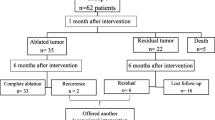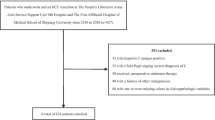Abstract
Background and Aim
Extremely poor prognosis in hepatocellular carcinoma (HCC) patients with progressing disease was denoted by vascular invasion. Cytokeratin 18 (CK18) has been shown to be overexpressed in hepatocellular carcinoma so it is a valuable tumor marker; however, its role in vascular invasion is still unclear. This study aimed to predict CK18 as a predictive marker for macrovascular malignant invasion.
Methods
The present study was conducted on three groups of patients: group I included 91 HCC patients without macrovascular invasion, group II included 34 HCC patients with radiological evidence of vascular invasion, and group III included 110 control individuals subdivided into IIIA as healthy blood donors and IIIB as post-HCV cirrhotic patients without HCC.
Results
ROC curve of M30 fragments of CK18 was constructed for discrimination between HCC with and without macrovascular invasion. Optimum cutoff value was 304.5 ng/mL (AUC = 0.997, P < 0.001), sensitivity (100%) and specificity (98.8%). Regression analysis was conducted for prediction of macrovascular invasion within HCC patients. The following variables: higher levels of AST, M30, bilirubin, and AFP, lower levels of serum albumin, larger tumor size, child B score, and multiple lesions were associated with vascular invasion in univariate analysis. While in multivariate analysis, higher levels of AST and bilirubin and elevated levels of M30 and AFP serum were considered independent predictors for macrovascular invasion in HCC patients.
Conclusion
The present study suggests that increased M30 fragments of CK18 levels may be useful as a possible marker of early tumor invasiveness.




Similar content being viewed by others
References
Maillard E. Epidemiology, natural history and pathogenesis of hepatocellular carcinoma. Cancer Radiother. 2011;15:3–6.
Nagashima I, Hamada C, Naruse K, et al. Surgical resection for small hepatocellular carcinoma. Surgery. 1996;119:40–5.
Seki T, Wakabayashi M, Nakagawa T, et al. Ultrasonically guided percutaneous microwave coagulation therapy for small hepatocellular carcinoma. Cancer. 1994;74:817–25.
Choi D, Lim HK, Rhim H, et al. Percutaneous radiofrequency ablation for early-stage hepatocellular carcinoma as a first-line treatment: long-term results and prognostic factors in a large single-institution series. Eur Radiol. 2007;17:684–92.
Giannelli G, Pierri F, Trerotoli P, et al. Occurrence of portal vein tumor thrombus in hepatocellular carcinoma affects prognosis and survival. A retrospective clinical study of 150 cases. Hepatol Res. 2002;24:50.
Zhou YM, Yang JM, Li B, et al. Risk factors for early recurrence of small hepatocellular carcinoma after curative resection. Hepatobiliary Pancreat Dis Int. 2010;9(1):33–7.
Jonas S, Bechstein WO, Steinmüller T, et al. Vascular invasion and histopathologic grading determine outcome after liver transplantation for hepatocellular carcinoma in cirrhosis. Hepatology. 2001;33:1080–6.
Choi JY, Lee JM, Sirlin CB. CT and MR imaging diagnosis and staging of hepatocellular carcinoma. Part I. Development, growth, and spread: key pathologic and imaging aspects. Radiology. 2014;272(3):635–54.
Van Eyken P, Desmet VJ. Cytokeratins and the liver. Liver. 1993;13:113–22.
Morris KL, Tugwood JD, Khoja L, et al. Circulating biomarkers in hepatocellular carcinoma. Cancer Chemother Pharmacol. 2014;74(2):323–32.
Linder S, Havelka AM, Ueno T, Shoshan MC. Determining tumor apoptosis and necrosis in patient serum using cytokeratin 18 as a biomarker. Cancer Lett. 2004;214:1–9.
Fabregat I, Roncero C, Fernandez M. Survival and apoptosis: a dysregulated balance in liver cancer. Liver Int. 2007;27:155–62.
Patel T. Immune escape in hepatocellular cancer: is a good offense the best defense? Hepatology. 1999;30:576–8.
Elalfy H, Besheer T, El-Hussiny MA, et al. Risk of early hepatocellular carcinoma recurrence after curative ablation: association with cytokeratine 18. Int J Adv Res. 2015;3(3):1194–206.
Ünal E, İdilman IS, Akata D, Özmen MN, Karçaaltıncaba M. Microvascular invasion in hepatocellular carcinoma. Diagn Interv Radiol. 2016;22(2):125–132. doi:10.5152/dir.2016.15125.
Lim KC, Chow PK, Allen JC, et al. Microvascular invasion is a better predictor of tumor recurrence and overall survival following surgical resection for hepatocellular carcinoma compared to the Milan criteria. Ann Surg. 2011;254:108–13. [CrossRef]
Shah SA, Greig PD, Gallinger S, et al. Factors associated with early recurrence after resection for hepatocellular carcinoma and outcomes. J Am Coll Surg. 2006;202:275–83. [CrossRef]
Sumie S, Kuromatsu R, Okuda K, et al. Microvascular invasion in patients with hepatocellular carcinoma and its predictable clinicopathological factors. Ann Surg Oncol. 2008;15:1375–82. [CrossRef]
Taylor-Robinson SD, Foster GR, Arora S, Hargreaves S, Thomas HC. Increase in primary liver cancer in the UK, 1979-94. Lancet. 1997;350:1142–3.
International Agency for Cancer Research. GLOBOCAN 2002. http://www-dep.iarc.fr. Accessed 20 Jan 2010.
Umemura T, Ichijo T, Yoshizawa K, Tanaka E, Kiyosawa K. Epidemiology of hepatocellular carcinoma in Japan. J Gastroenterol. 2009;44(Suppl 19):102–7.
Asaoka Y, Tateishi R, Nakagomi R, et al. Frequency of and predictive factors for vascular invasion after radiofrequency ablation for hepatocellular carcinoma. PLoS One. 2014;9:e111662.
Matsumata T, Kanematsu T, Takenaka K, Yoshida Y, Nishizaki T, Sugimachi K. Patterns of intrahepatic recurrence after curative resection of hepatocellular carcinoma. Hepatology. 1989;9:457–60.
Toyosaka A, Okamoto E, Mitsunobu M, Oriyama T, Nakao N, Miura K. Pathologic and radiographic studies of intrahepatic metastasis in hepatocellular carcinoma; the role of efferent vessels. HPB Surg. 1996;10:97–103.
Yamamoto J, Kosuge T, Takayama T, et al. Recurrence of hepatocellular carcinoma after surgery. Br J Surg. 1996;83:1219–22.
Choi KK, Kim SH, Choi SB, et al. Portal venous invasion: the single most independent risk factor for immediate postoperative recurrence of hepatocellular carcinoma. J Gastroenterol Hepatol. 2011;26:1646–51.
Kaibori M, Ishizaki M, Matsui K, Kwon AH. Predictors of microvascular invasion before hepatectomy for hepato-cellular carcinoma. J Surg Oncol. 2010;102:462–8.
Kim BK, Han KH, Park YN, et al. Prediction of microvascular invasion before curative resection of hepatocellular carcinoma. J Surg Oncol. 2008;97:246–52.
Eguchi S, Takatsuki M, Hidaka M, et al. Predictor for histological microvascular invasion of hepatocellular carcinoma: a lesson from 229 consecutive cases of curative liver resection. World J Surg. 2010;34:1034–8.
Esnaola NF, Lauwers GY, Mirza NQ, et al. Predictors of microvascular invasion in patients with hepatocellular carcinoma who are candidates for orthotopic liver transplantation. J Gastrointest Surg. 2002;6:224–32.
Imamura H, Matsuyama Y, Tanaka E, et al. Risk factors contributing to early and late phase intrahepatic recurrence of hepatocellular carcinoma after hepatectomy. J Hepatol. 2003;38:200–7.
Kim B, Kim Y, Wang H, Kim M. Risk factors for immediate post-operative fatal recurrence after curative resection of hepatocellular carcinoma. World J Gastroenterol. 2006;12:99–104.
Sherman M. Alphafetoprotein: an obituary. J Hepatol. 2001;34:603–5.
Ho CC, Cheng CC, Liu YH, et al. Possible relation between histone 3 and cytokeratin 18 in human hepatocellular carcinoma. In Vivo. 2008;22:457–62.
Kawai M, Saegusa Y, Kemmochi S, et al. Cytokeratin 8/18 is a useful immunohistochemical marker for hepatocellular proliferative lesions in mice. J Vet Med Sci. 2010;72:263–9.
Yilmaz Y. Systematic review: caspase-cleaved fragments of cytokeratin 18—the promises and challenges of a biomarker for chronic liver disease. Aliment Pharmacol Ther. 2009;30:1103–9.
Najimi M, Smets F, Sokal E. Hepatocyte apoptosis. Methods Mol Biol. 2009;481:59–74.
Goon PKY, Lip GYH, Stonelake PS, Blann AD. Circulating endothelial cells and circulating progenitor cells in breast cancer: relationship to endothelial damage/dysfunction/apoptosis, clinicopathologic factors, and the Nottingham Prognostic Index. Neoplasia. 2009;11:771–9.
González JJ, Bernardo CG, Sanz L, et al. Mismatch repair protein MSH2, cytokeratin 18 and cytokeratin 20 expression: clinicopathological correlation and prognostic value in colorectal cancer patients. Hepato-Gastroenterology. 2007;54(80):2266–71.
Author information
Authors and Affiliations
Corresponding author
Ethics declarations
Conflict of Interest
The authors declare that they have no conflicts of interest. The authors alone are responsible for the content and writing of the paper.
Funding Resources
No funding was received; the authors used the equipment of Mansoura University Hospital.
Ethical Approval
Informed consent was taken from each patient. The research protocol was approved by the Ethical Committee of the Faculty of Medicine, Mansoura University.
Submission Declaration
The manuscript has not been published elsewhere and has not been submitted simultaneously for publication elsewhere.
Electronic Supplementary Material
Rights and permissions
About this article
Cite this article
Elalfy, H., Besheer, T., Arafa, M.M. et al. Caspase-Cleaved Cytokeratin 18 Fragment M30 as a Potential Biomarker of Macrovascular Invasion in Hepatocellular Carcinoma. J Gastrointest Canc 49, 260–267 (2018). https://doi.org/10.1007/s12029-017-9937-6
Published:
Issue Date:
DOI: https://doi.org/10.1007/s12029-017-9937-6




